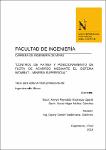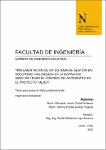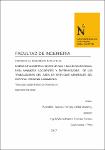Mostrar el registro sencillo del ítem
Control de fatiga y posicionamiento de flota de acarreo mediante el sistema Wombat – minería superficial
| dc.contributor.advisor | Valderrama Gutiérrez, Danny Daniel | |
| dc.contributor.author | Espinoza Ugarte, Kenyo Reynaldo | |
| dc.contributor.author | Muñoz Sánchez, Oscar Aliger | |
| dc.date.accessioned | 2017-08-10T21:21:26Z | |
| dc.date.available | 2017-08-10T21:21:26Z | |
| dc.date.issued | 2016-12-07 | |
| dc.identifier.citation | Espinoza, K. R., & Muñoz, O. A. (2016). Control de fatiga y posicionamiento de flota de acarreo mediante el sistema Wombat – minería superficial (Tesis de licenciatura). Repositorio de la Universidad Privada del Norte. Recuperado de https://hdl.handle.net/11537/10684 | es_PE |
| dc.identifier.other | 622 ESPI/C 2016 | es_PE |
| dc.identifier.uri | https://hdl.handle.net/11537/10684 | |
| dc.description.abstract | RESUMEN En la presente tesis describimos un potencial sistema anti-fatiga llamado WOMBAT de la empresa WOMBATT PERU S.A.C, el cual tiene por objetivo principal disminuir, controlar y eliminar los incidentes por fatiga en operadores de camiones de acarreo en minería superficial, ya que es un problema potencial que las mineras están enfrentando actualmente por el mal descanso y los sistemas atípicos de trabajo que tienen los operadores, este problema es conocido como fatiga que está relacionada a una respuesta protectora del organismo que obliga al sujeto a detener o, por lo menos, disminuir la intensidad de la actividad que está realizando. Este estímulo corresponde al estado en el cual el sujeto no descansa o no duerme en forma apropiada, generando una condi ción riesgosa para la labor que se está desempeñando. En minería la fatiga laboral es considerada como un grave problema que afecta la salud de los trabajadores, reduce su rendimiento, contribuye a la baja productividad y aumenta el riesgo de sufrir accidentes en el lugar de trabajo, aumentando así no sólo los costos operacionales sino que también puede ser la causa para que la unidad minera tenga un cierre temporal o definitivo de acuerdo a la severidad del accidente (accidente fatal). Los sistemas que fueron generados al ver la necesidad de alguna ayuda para poder controlar y eliminar la fatiga fueron catalogados como detectores y otros como predictores; muchas veces los detectores de fatiga funcionaban y algunas no, dado a que este sistema se activa al ver que el usuario ya está con fatiga (ojos cerraros, cabeceos, etc.) y además se usaba sin intervención humana ni un adecuado protocolo el cual serviría para verificar los procedimientos a los cuales están sujeto dichos sistemas. En cambio los sistemas predictores son activados antes o mucho antes que el usuario sienta cansancio o fatiga dando así una mejor respuesta e intervención para poder disminuir los eventos de incidentes y accidentes por fatiga. El SISTEMA WOMBAT es un predictor de fatiga que trabaja con parámetros como tiempo de trabajo, virajes, descanso previo al trabajo y el ciclo circadiano de sueño y cansancio; los cuales se combinan con el logaritmo que el ASTID tiene pre configurado de acuerdo al nivel de cultura de descanso del proyecto, entrelazan informaciones y van dando un cierto score el cual indica el nivel de fatiga del operador, este sistema cuenta con dos “alertas”, entre ellas las alertas de color “naranja” el cual nos indica que un determinado operador debe ser interrogado para saber su estado de actividad, de fatiga o cansancio; y la alerta “roja” el cual nos indica que el operador esta o puede estar cerca a desenlazar un estado de fatiga. Además el sistema cuenta con un mapa en el cual está constituido con un sistema de ubicación de cada unidad de acarreo con el nombre del operador, hora, velocidad y condición del vehículo (apagado o encendido). Este complemento del sistema es de gran ayuda al momento de administrar los tiempos ya que se podría trabajar con el como un asistente para la flota de acarreo y también para el de carguío ya que sabremos si las palas tienen tiempo muerto y necesitan más camiones. Por lo tanto, podríamos decir que el SISTEMA WOMBAT surgió como una respuesta a la necesidad constante de mejoramiento de la seguridad operacional, disminución y eliminación de incidentes y accidentes por fatiga, con un enfoque orientado hacia el rendimiento de los trabajadores, la salud operacional y la asistencia en el manejo de flotas de acarreo. | es_PE |
| dc.description.abstract | ABSTRACT In this thesis we describe a potential anti-fatigue system called WOMBAT of WOMBATT PERU SAC, whose main objective is to reduce, control and eliminate fatigue incidents in haul truck operators in surface mining, since it is a problem Potential that the miners are currently facing due to the bad rest and the atypical systems of work that the operators have, this problem is known as fatigue that is related to a protective response of the organism that forces the subject to stop or at least to diminish The intensity of the activity you are doing. This stimulus corresponds to the state in which the subject does not rest or do not sleep properly, generating a risky condition for the work being performed. In mining, labor fatigue is considered a serious problem that affects the health of workers, reduces their performance, contributes to low productivity and increases the risk of accidents in the workplace, thus increasing not only operational costs but also Can also be the cause for the mining unit to have a temporary or definitive closure according to the severity of the accident (fatal accident). The systems that were generated to see the need for some help to control and eliminate fatigue were classified as detectors and others as predictors; Many times the fatigue detectors worked and some did not, given that this system is activated to see that the user is already fatigued (eyes closed, nods, etc.) and also was used without human intervention nor an appropriate protocol which would serve To verify the procedures to which those systems are subject. In contrast, the predictive systems are activated before or long before the user feels fatigue or fatigue thus giving a better response and intervention in order to reduce the events of incidents and accidents by fatigue The WOMBAT SYSTEM is a predictor of fatigue that works with parameters such as work time, turns, pre-work rest and the circadian cycle of sleep and fatigue; Which are combined with the logarithm ASTID has pre-configured according to the rest culture level of the project, interleave information and give a certain score which indicates the level of operator fatigue, this system has two "alerts" , Among them the alerts of color "orange" which tells us that a certain operator must be interrogated to know their state of activity, fatigue or fatigue; And the "red" alert which indicates that the operator is or may be close to untying a state of fatigue. In addition the system has a map in which it is constituted with a system of location of each unit of carry with the name of the operator, hour, speed and condition of the vehicle (off or on). This complement of the system is very useful when managing the times since you could work with him as an assistant for the fleet of haulage and also for the haulage as we will know if the blades have dead time and need more trucks. Therefore, we could say that WOMBAT SYSTEM emerged as a response to the constant need for improvement of safety, reduction and elimination of incidents and accidents by fatigue, with a focus on worker performance, operational health and Assistance in handling fleets of haulage. | es_PE |
| dc.description.uri | Tesis | es_PE |
| dc.format | application/pdf | es_PE |
| dc.format | application/msword | es_PE |
| dc.language.iso | spa | es_PE |
| dc.publisher | Universidad Privada del Norte | es_PE |
| dc.rights | info:eu-repo/semantics/openAccess | es_PE |
| dc.rights | Atribución-NoComercial-CompartirIgual 3.0 Estados Unidos de América | es_PE |
| dc.rights.uri | https://creativecommons.org/licenses/by-nc-sa/3.0/us/ | * |
| dc.source | Universidad Privada del Norte | es_PE |
| dc.source | Repositorio Institucional - UPN | es_PE |
| dc.subject | Estudios de fatiga | es_PE |
| dc.subject | Prevención de accidentes | es_PE |
| dc.subject | Salud ocupacional | es_PE |
| dc.subject | Minería | es_PE |
| dc.title | Control de fatiga y posicionamiento de flota de acarreo mediante el sistema Wombat – minería superficial | es_PE |
| dc.type | info:eu-repo/semantics/bachelorThesis | es_PE |
| thesis.degree.grantor | Universidad Privada del Norte. Facultad de Ingeniería | es_PE |
| thesis.degree.level | Título Profesional | es_PE |
| thesis.degree.discipline | Ingeniería de Minas | es_PE |
| thesis.degree.name | Ingeniero de Minas | es_PE |
| dc.publisher.country | PE | es_PE |
| dc.subject.ocde | https://purl.org/pe-repo/ocde/ford#2.07.05 | es_PE |
| thesis.degree.program | Pregrado | es_PE |
| dc.description.sede | Cajamarca | es_PE |
| renati.advisor.dni | 43311969 | |
| renati.author.dni | 47143861 | |
| renati.author.dni | 45620452 | |
| renati.discipline | 724026 | es_PE |
| renati.juror | Ardito Vega, José Antonio | |
| renati.juror | Marinovic Pulido, Alex Patricio | |
| renati.juror | Torres García, Percy Luis | |
| renati.level | https://purl.org/pe-repo/renati/level#tituloProfesional | es_PE |
| renati.type | https://purl.org/pe-repo/renati/type#tesis | es_PE |
Ficheros en el ítem
Este ítem aparece en la(s) siguiente(s) colección(ones)
-
Tesis [537]






